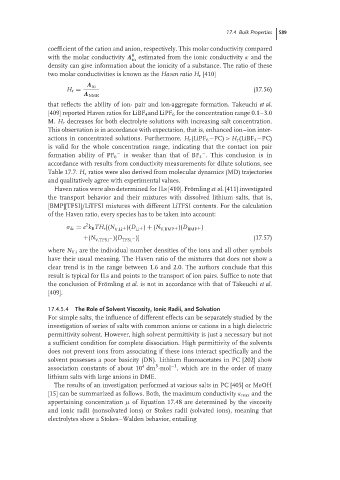Page 615 - Handbook of Battery Materials
P. 615
17.4 Bulk Properties 589
coefficient of the cation and anion, respectively. This molar conductivity compared
with the molar conductivity Λ 0 m estimated from the ionic conductivity κ and the
density can give information about the ionicity of a substance. The ratio of these
two molar conductivities is known as the Haven ratio H r [410]
Λ m
H r = (17.56)
Λ NMR
that reflects the ability of ion- pair and ion-aggregate formation. Takeuchi et al.
[409] reported Haven ratios for LiBF 4 and LiPF 6 for the concentration range 0.1–3.0
M. H r decreases for both electrolyte solutions with increasing salt concentration.
This observation is in accordance with expectation, that is, enhanced ion–ion inter-
actions in concentrated solutions. Furthermore, H r (LiPF 6 −PC) > H r (LiBF 4 −PC)
is valid for the whole concentration range, indicating that the contact ion pair
− −
formation ability of PF 6 is weaker than that of BF 4 . This conclusion is in
accordance with results from conductivity measurements for dilute solutions, see
Table 17.7. H r ratios were also derived from molecular dynamics (MD) trajectories
and qualitatively agree with experimental values.
Haven ratios were also determined for ILs [410]. Fr¨ omling et al. [411] investigated
the transport behavior and their mixtures with dissolved lithium salts, that is,
[BMP][TFSI]/LiTFSI mixtures with different LiTFSI contents. For the calculation
of the Haven ratio, every species has to be taken into account:
2
σ dc = e k B TH r [(N V,Li +)(D +) + (N V,BMP +)(D BMP +)
Li
+(N V,TFSI −)(D TFSI −)] (17.57)
where N V,i are the individual number densities of the ions and all other symbols
have their usual meaning. The Haven ratio of the mixtures that does not show a
clear trend is in the range between 1.6 and 2.0. The authors conclude that this
result is typical for ILs and points to the transport of ion pairs. Suffice to note that
the conclusion of Fr¨ omling et al. is not in accordance with that of Takeuchi et al.
[409].
17.4.5.4 The Role of Solvent Viscosity, Ionic Radii, and Solvation
For simple salts, the influence of different effects can be separately studied by the
investigation of series of salts with common anions or cations in a high dielectric
permittivity solvent. However, high solvent permittivity is just a necessary but not
a sufficient condition for complete dissociation. High permittivity of the solvents
does not prevent ions from associating if these ions interact specifically and the
solvent possesses a poor basicity (DN). Lithium fluoroacetates in PC [202] show
3
−1
4
association constants of about 10 dm ·mol , which are in the order of many
lithium salts with large anions in DME.
The results of an investigation performed at various salts in PC [405] or MeOH
[15] can be summarized as follows. Both, the maximum conductivity κ max and the
appertaining concentration µ of Equation 17.48 are determined by the viscosity
and ionic radii (nonsolvated ions) or Stokes radii (solvated ions), meaning that
electrolytes show a Stokes–Walden behavior, entailing

